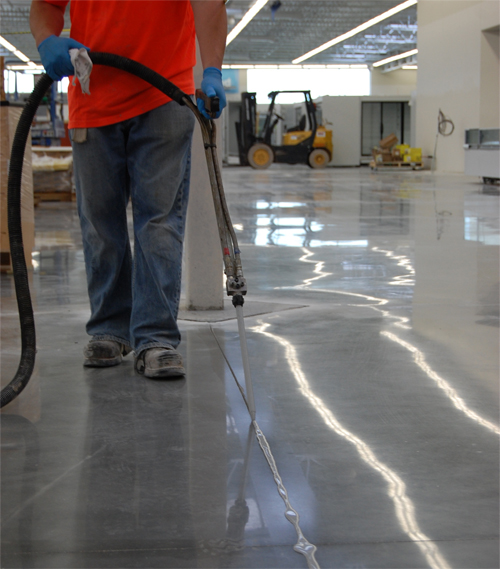
![]()
Concrete floors can crack, the concrete is laid in slabs with joints to help prevent cracking. ...But then what? Do you just leave the joints open once the concrete is laid? Nope! You use a joint sealant! This not only protect the joints, but it also makes the floors more eye appealing. There are multiple options of joint fillers and sealants available.
First you want to consider the concrete slabs environment. You want to make sure that the joints are properly filled depending on the environment. For example, if concrete floor joints in industrial environments are not filled properly, vehicles such as forklifts can damage the concrete. Filling the joints properly protects the edges of the joints and allows for load transfer between the slabs, otherwise the concrete would break off under the hard wheels of heavy equipment.
There are many options for joint fillers available, two types of fillers are semirigid polyureas and semi rigid epoxies, which can be tinted to match any color. One of the differences between them is the amount of time they take to set. The epoxy usually takes 8 to 12 hours to set and the polyurea takes anywhere from 30 minutes to about two hours to set.
To properly protect the edges of the slabs it is imperative to ensure that the filler is level with the surface of the floor. To do this, the joint is overfilled and allowed to harden, then the excess filler is scraped off with a scraping tool. There is a companion product available to use to prevent the surface from becoming stained from the joint filler. The product is a stain preventing film that is applied before using the joint filler. It is also important to keep in mind that semi rigid epoxy joint fillers can become discolored when exposed to ultraviolet light.
Using a joint sealant is important to keep water and moisture out of the concrete. Before applying a sealant it is important to ensure that the concrete has cured entirely and is completely free of moisture. After applying the sealant it will take about seven days to cure completely. Sealants will also keep other debris out such as dirt. You definitely do not want dirt and other things building up in your concrete. It is also important to consider the size of the joints when choosing sealants. When the joint is less than ⅜ of an inch wide a single component product is ideal and if the joint is wider than that then a dual component polyurea product works well.
It important to consider the quality and properties of the sealants as well. Some sealants can withstand liquid better than others. If needing to seal joints near a swimming pool a two-part polysulfide joint sealant is ideal. This type of sealant will self level and set like a rubber material. It is also important to find out if a stain preventing film is needed or not or if tape should be used to section off areas before applying the sealant. Is the sealant self leveling or will you need to use a scraping tool? Remember to keep in mind the type of environment and traffic the surface will endure when selecting your fillers and sealants. (For more information on sealing joints click here.)
At Custom Concrete Creations we have state of the art equipment and a properly trained team with years of experience. Custom Concrete Creations is a premier contractor serving the Omaha area as well at the Midwest. Give us a call or send us an email for your custom concrete finishing needs today!
